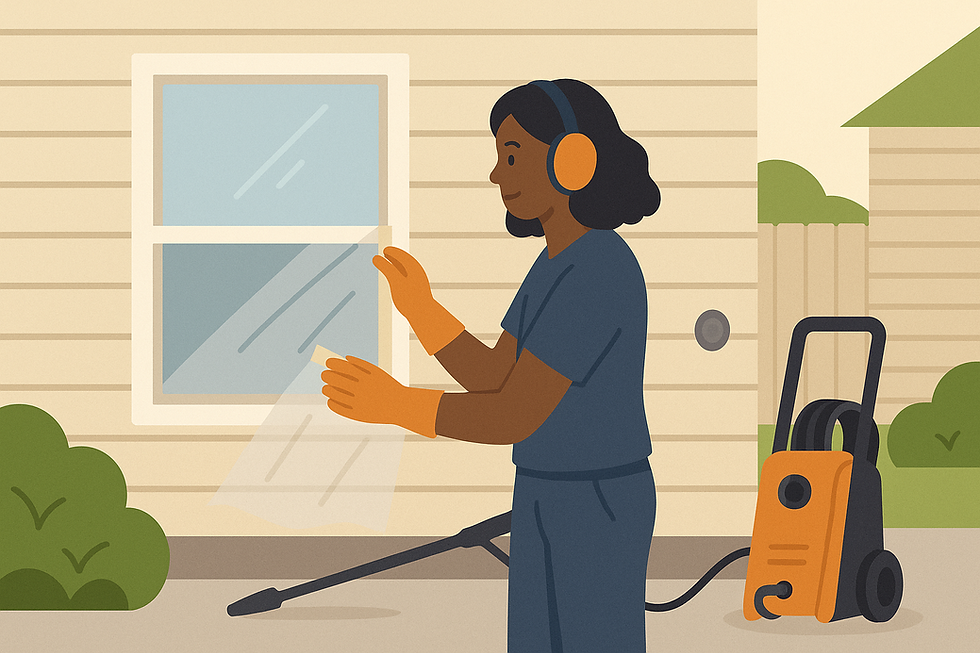What Preparations Are Needed Before Pressure Washing?
- Vanessa Brown
- Sep 9, 2025
- 3 min read
Pressure washing is a powerful and efficient way to clean your home’s exterior surfaces, including siding, decks, driveways, and patios. But before you fire up the machine and start spraying, it’s crucial to properly prepare the area. Taking the right steps beforehand ensures a more effective clean, protects your property, and helps prevent costly mistakes.
In this article, we’ll walk you through the key preparations you should make before pressure washing to keep your home and surroundings safe—and to get the best possible results.

Inspect the Surface to Be Cleaned
Before doing anything else, carefully inspect the area you plan to pressure wash. Look for:
Cracks in concrete or siding
Loose paint or shingles
Signs of mold, mildew, or algae
Delicate materials that may need soft washing instead
Identifying trouble spots early helps you decide whether to proceed with pressure washing, make repairs first, or adjust your pressure settings to avoid damage.
Clear the Area
Remove all items from the space you’ll be cleaning. This includes:
Patio furniture
Grills
Planters
Vehicles
Toys or bikes
Clearing the area makes it easier to maneuver the pressure washer and ensures nothing gets damaged or accidentally sprayed with high-pressure water.
Cover or Protect Nearby Items
Anything that can’t be moved—such as light fixtures, electrical outlets, air conditioning units, or landscaping—should be covered or shielded from the spray. Use plastic sheeting or waterproof tarps to protect:
Electrical boxes and outlets
Exterior light fixtures
Vents or dryer openings
Plants and shrubs near the cleaning area
This step helps prevent water intrusion, electrical hazards, and accidental damage to delicate foliage or equipment.
Close Windows and Doors
Pressure washing can send water spraying in all directions. Before starting, ensure all windows and doors are securely closed. It’s also a good idea to check for gaps in weatherstripping that could allow water to seep inside.
For extra protection, consider placing towels or rags along the base of doors inside the home if you’re pressure washing close to entry points.
Turn Off Power to Outdoor Electrical Sources
If you’ll be washing near outdoor electrical outlets, lighting, or your home’s HVAC unit, turn off the power at the breaker to avoid any risk of electric shock. Water and electricity don’t mix, and safety should always be a top priority when pressure washing.
Pre-Treat Stains and Growth
If you're dealing with stubborn stains, grease, or organic growth like mold or algae, it’s smart to pre-treat those areas with a cleaning solution. Use a mold- or mildew-killing detergent or degreaser and allow it to sit for several minutes before pressure washing. This helps loosen buildup and reduces the amount of pressure needed to clean the surface.
Choose the Right Nozzle and Pressure Setting
Different surfaces require different levels of pressure. Using the wrong nozzle can lead to ineffective cleaning—or worse, damage to your siding, deck, or paint. Here are a few quick guidelines:
Use a wide-angle nozzle (25–40 degrees) for delicate surfaces
Use a narrow-angle nozzle (0–15 degrees) for tough stains on concrete or brick
Test on a small, hidden area before pressure washing the full surface
If you're unsure which pressure setting or nozzle is appropriate, consult your pressure washer manual or consider hiring a professional.
Final Thoughts
Pressure washing is a great way to refresh your home’s exterior—but it’s not just about turning on a machine and blasting away dirt. Proper preparation is key to achieving a thorough, safe, and damage-free clean.
By inspecting surfaces, protecting nearby areas, securing doors and windows, and using the right tools and cleaning agents, you’ll be set up for success. Whether you're cleaning a small patio or an entire house, investing time in prep work ensures better results and greater peace of mind.
Ready to give your home a fresh, clean look? Contact us today to schedule professional pressure washing or get expert advice on how to prep your space for a safe and effective DIY job.


